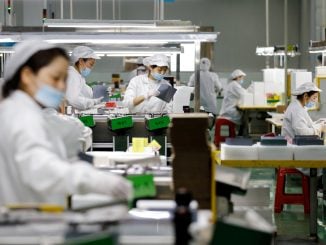BANGKOK — China’s ruling Communist Party released a 50-page roadmap addressing long-term challenges confronting the world’s second-largest economy. At the same time, the central bank cut key interest rates Monday in a surprise move to pep up the struggling property sector.
The action by the People’s Bank of China was a short-term adjustment that appeared to signal a recognition that the economy needs immediate help to complement the party’s broader ambitions of following leader Xi Jinping’s vision for transforming China into a “high-standard socialist market economy in all respects” by 2035.
“If we are to break new ground in advancing Chinese modernization on the new journey in the new era, we must continue to rely on reform and opening up,” Xi said in a written explanation of reforms endorsed last week at a four-day policy-setting meeting.
Overall, the outline of reforms aligns with the ruling party’s longstanding ambitions to cement China’s status as a leading technology and economic power while addressing imbalances in its economy, which expanded at a slower-than-expected 4.7% annual pace in the last quarter, down from 5.3% in January-March.
The party’s latest plan, 50 pages long in English, contains more than 300 reforms including promises to beef up social welfare such as pensions and health care, improve local government finances and protect private property rights.
It promises a “first-rate business environment” that will protect the rights and interests of foreign investors and make it more convenient for people from elsewhere to live in China. It also pledges equal market access and support for private and state-owned enterprises and better “international coordination” of economic policies.
But the reforms also prioritize national security, Xi said. That may prove troubling to foreign companies operating in China, which say ever-widening definitions of what might affect national security pose a serious risk to their operations and employees.
The document released Sunday is more detailed than a communique released Thursday after the party meeting ended. But the reforms it promises are laid out in broad strokes, with constant references to developing “mechanisms” to address every problem — the word mechanism appears 200 times in the English version and 242 times in Chinese.
Actual laws and regulations for achieving the goals of the policy roadmap will come later.
“We think these measures, if well implemented promptly, should help improve resource allocation, contain financial risks, unleash some growth potential, and underpin investors’ confidence, while the actual implementation and policy clarity and sustainability will be the key,” UBS economists Nina Zhang and Tao Wang said in a report.
The party has acknowledged some of the thorniest problems that have slowed China’s recovery from the disruptions of the COVID-19 pandemic, chief among them weak consumer demand.
A prolonged slump in the property market after regulators cracked down on excessive developer borrowing unleashed a chain reaction that has pulled housing sales and prices lower and hit many other parts of the economy, such as construction, building materials and home appliances.
The party’s plan includes pledges to provide more affordable housing, reform financing of property development, raise rural incomes and “properly regulate excessive incomes.”
Rural migrants should have the same access to public services as long-term city dwellers, and the government will enact more incentives, including subsidies, to encourage Chinese families to have more children, the document says.
As pressures have mounted in the economy and markets, regulators have been fine-tuning policy tools, relaxing restrictions on property purchases and tinkering with monetary policy.
So far, China’s leaders have avoided the massive stimulus other major economies deployed during the pandemic. But their latest meeting did promise more government spending to help spur growth, said Julian Evans-Pritchard of Capital Economics.
“While today’s rate cuts offer some reassurance that policymakers are being responsive to the recent loss of economic momentum, the heavy lifting will need to come from fiscal, not monetary, policy,” he said in a report.
Early Monday, the central bank cut the five-year loan prime rate, which is a benchmark for mortgages, to 3.85% from 3.95%. The one-year loan prime rate, which affects most business loans, fell to 3.35% from 3.45%. The PBOC also reduced its required collateral for medium-term loans to banks and injected more funds into the banking system.




